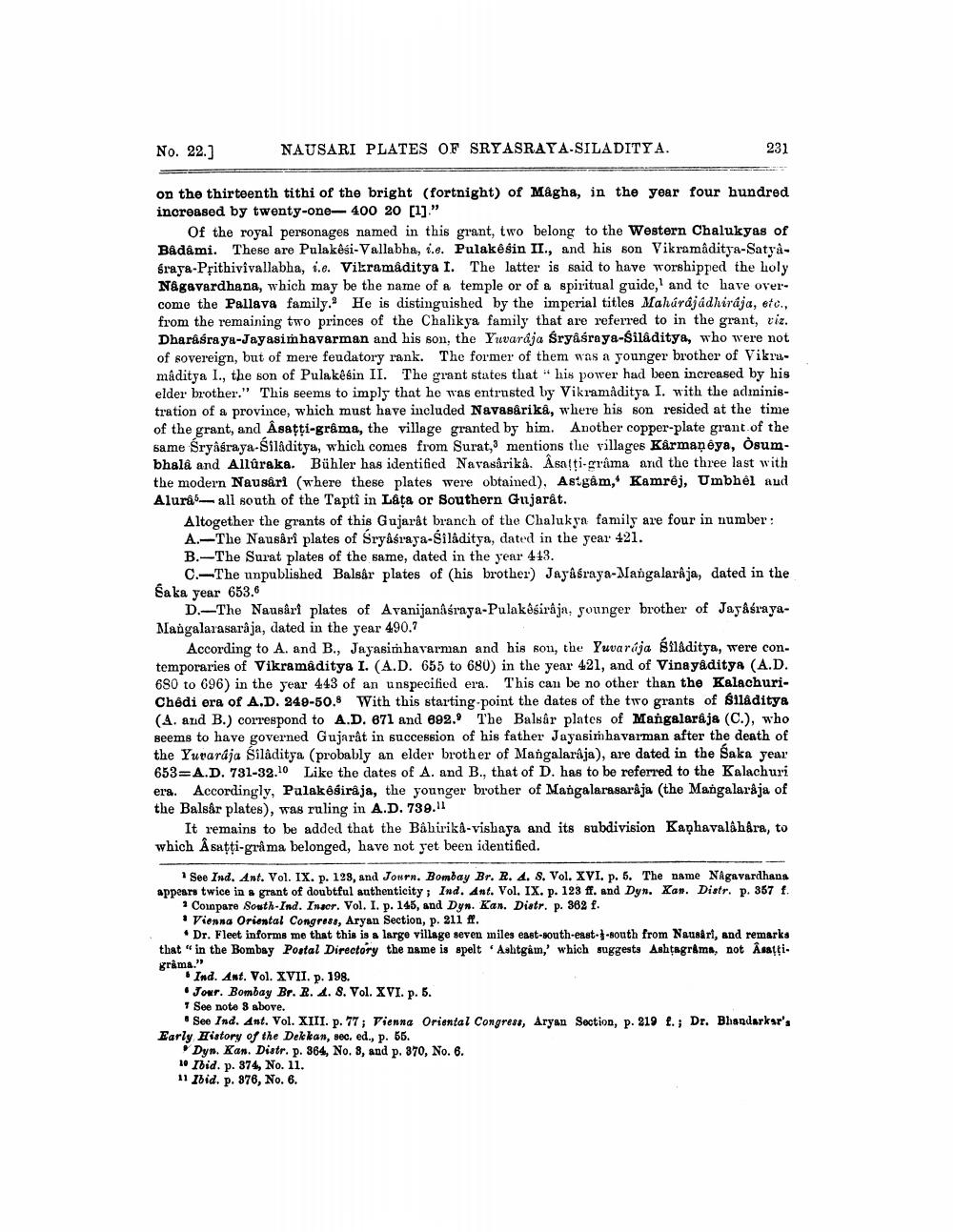________________
No. 22.]
NAUSARI PLATES OF SRY ASRAYA-SILADITYA.
231
on the thirteenth tithi of the bright (fortnight) of Magha, in the year four hundred increased by twenty-one-400 20 [1]."
Of the royal personages named in this grant, two belong to the Western Chalukyas of Badâmi. These are Pulakési-Vallabha, 1.6. Pulakésin II., and his son Vikramaditya-Satyaśraya-Prithivivallabha, 1.e. Vikramaditya I. The latter is said to have worshipped the holy Någavardhana, which may be the name of a temple or of a spiritual guide, and to have overcome the Pallava family. He is distinguished by the imperial titles Mahúrájádhírája, etc., from the remaining two princes of the Chalikya family that are referred to in the grant, riz. Dharâśraya-Jayasimhavarman and his son, the Yuvarája śryåśraya-siladitya, who were not of sovereign, but of mere feudatory rank. The former of them was a younger brother of Vikramaditya I., the son of Pula kesin II. The grant states that ** his power had been increased by his elder brother." This seems to imply that he was entrusted by Vikramaditya I. with the administration of a province, which must have included Navasárika, where his son resided at the time of the grant, and Âsaţți-grâma, the village granted by him. Another copper-plate grant of the same Sryasraya-Siladitya, which comes from Surat, mentions the villages Kårmanêya, Osumbhalâ and Allûraka. Bühler has identified Navasárika. Asalţi-grama and the three last with the modern Nausâri (where these plates were obtained), Astgâm, Kamrêj, Umbhel aud Alura-all south of the Taptî in Lata or Southern Gujarat.
Altogether the grants of this Gujarat branch of the Chalukya family are four in number: A.-The Nausari plates of Sryasraya-Siladitya, dated in the year 421. B.-The Surat plates of the same, dated in the year 413.
C.-The unpublished Balsár plates of his brother) Jayasraya-Mangalarkja, dated in the Saka year 653.6
D.-The Nausâri plates of Avanijanaśraya-Pulakésiraja, younger brother of JayasrayaMangalarasaraja, dated in the year 490.7
According to A. and B., Jayasimhavarman and his son, the Yuvarája silAditya, were contemporaries of Vikramaditya I. (A.D. 655 to 680) in the year 421, and of Vinayaditya (A.D. 680 to 696) in the year 443 of an unspecified era. This can be no other than the KalachuriChêdi era of A.D. 249-50. With this starting point the dates of the two grants of biladitya (4. and B.) correspond to A.D. 671 and 892. The Balsar plates of Mangalarája (C.), who seems to have governed Gujarat in succession of his father Jayasimhavarman after the death of the Yurarája Silâditya (probably an elder brother of Mangalarája), are dated in the Saka year 653=A.D. 731-32.10 Like the dates of A. and B., that of D. has to be referred to the Kalachuri era. Accordingly, Palakêśiraja, the younger brother of Mangalarasaraja (the Mangalaraja of the Balsår plates), was ruling in A.D. 739.11
It remains to be added that the Bâhiriki-vishaya and its subdivision Kanhavalahára, to which Āsatti-grå ma belonged, have not yet been identified.
See Ind. Ant. Vol. IX. p. 123, and Journ. Bombay Br. R. 4. 8. Vol. XVI. p. 5. The name Nagavardhana appears twice in a grant of doubtful authenticity; Ind. Ant. Vol. IX. p. 123 ff. and Dyn. Xan. Distr. p. 357 f.
- Compare South-Ind. Inger. Vol. I. p. 145, and Dyn. Kan. Distr. p. 362 f. • Vienna Oriental Congress, Aryan Section, p. 211 AP.
• Dr. Fleet informs me that this is a large village seven miles east-south-east-south from Nauart, and remarks that " in the Bombay Portal Directory the name is spelt Ashtgam, which suggests Ashtagrams, not Åsatti
grama."
. Ind. Ant. Vol. XVII. p. 198. • Jour. Bombay Br. R. 4. 8. Vol. XVI. p. 5.
See note 8 above.
See Ind. Ant. Vol. XIII. p. 77; Vienna Oriental Congress, Aryan Section, p. 219 L.; Dr. Bhandarkar's Early History of the Dekkan, sec, ed., p. 55.
Dyn. Kan. Distr. p. 364, No. 8, and p. 370, No. 6. 10 Ibid. p. 374, No. 11. 11 Ibid. p. 876, No. 6.




